|
|
|
Sort Order |
|
|
|
Items / Page
|
|
|
|
|
|
|
| Srl | Item |
| 1 |
ID:
123189
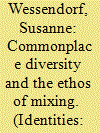

|
|
|
|
|
| Publication |
2013.
|
| Summary/Abstract |
The London Borough of Hackney is one of the most diverse places in Britain. It is characterised by a multiplicity of ethnic minorities, different migration histories, religions, educational and economic backgrounds both among long-term residents and newcomers. This article describes attitudes towards diversity in such a 'super-diverse' context. It develops the notion of 'commonplace diversity', referring to cultural diversity being experienced as a normal part of social life. While many people mix across cultural differences in public and associational space, this is rarely translated into private relations. However, this is not perceived as a problem, as long as people adhere to a tacit 'ethos of mixing'. This comes to the fore in relation to groups who are blamed to 'not want to mix' in public and associational space. The article discusses the fine balance between acceptable and unacceptable social divisions in relation to specific groups who are seen to lead separate lives.
|
|
|
|
|
|
|
|
|
|
|
|
|
|
|
|
| 2 |
ID:
123190
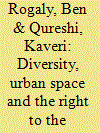

|
|
|
|
|
| Publication |
2013.
|
| Summary/Abstract |
Using three vignettes of the same physical space this article contributes to understanding of how the right to the city is contested in provincial England in the early twenty-first century. Oral history and ethnographic material gathered in Peterborough between 2010 and 2012 are drawn on to shed new light on the politics of diversity and urban space. This highlights the multiple place attachments and trans-spatial practices of all residents, including the white ethnic majority, as well as contrasting forms of active intervention in space with their different temporalities and affective intensities. The article carries its own diversity politics, seeking to reduce the harm done by racism through challenging the normalisation of the idea of a local, indigenous population, left out by multiculturalism. It simultaneously raises critical questions about capitalist regeneration strategies in terms of their impact both on class inequality and on the environment.
|
|
|
|
|
|
|
|
|
|
|
|
|
|
|
|
| 3 |
ID:
123188
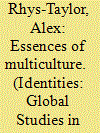

|
|
|
|
|
| Publication |
2013.
|
| Summary/Abstract |
This article applies methods and concepts derived from a 'sensory turn' within the social sciences to a street market, popular with migrants to East London, to explore the socio-sensory processes through which convivial metropolitan multiculture is produced. Arguing against critiques of 'eating the other' and reductive accounts of cross-cultural interaction (assimilation, acculturation, boutique cosmopolitanism, etc.), this article hones a sensory attention on the market place and reveals the ways urbanites come to live with difference and, between them, develop metropolitan multicultures.
|
|
|
|
|
|
|
|
|
|
|
|
|
|
|
|
| 4 |
ID:
123185
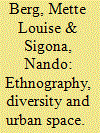

|
|
|
|
|
| Publication |
2013.
|
| Summary/Abstract |
This article is an introduction to a special issue on ethnography, diversity and urban space. It places the 'diversity turn' within studies of migration and multiculture historically and discusses the implications of concepts such as 'diversity' and more recently 'super-diversity' for scholarship, policy and identity politics. It argues that diversity is a helpful concept for studies of migration and multiculture because it avoids the essentialism and bias towards ethnic affiliation often characterising studies within the multiculturalism framework, while being more grounded locally than studies within the transnationalism framework. It examines the methodological implications of increasing diversity and complexity on ethnographic studies and the definition of the 'field'. It makes the point that increasing urban diversity poses a challenge to ethnographic ideals of 'immersion' and wholeness. Finally, it introduces the individual articles in the special issue.
|
|
|
|
|
|
|
|
|
|
|
|
|
|
|
|
| 5 |
ID:
123192
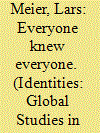

|
|
|
|
|
| Publication |
2013.
|
| Summary/Abstract |
This article explores the transformation of a community and its diversity as narrated by former industrial workers from a neighbourhood in Nuremberg, in a context in which company-based social housing of workers had been replaced by private rented accommodation accessed by middle class residents of migrant backgrounds. In biographical interviews, narratives emerge in which diversity and social difference are not seen as ethnic difference, but rather as a power difference within an established-outsider figuration. In this figuration, heterogeneous past and present cultural practices are homogenised through community control and regulation along normative rules as defined by the established. Workers' nostalgic laments for the loss of their former status show that figuration of established and outsiders is dynamic, opening up new ways of thinking about diverse place-making and alternative perspectives on urban gentrification.
|
|
|
|
|
|
|
|
|
|
|
|
|
|
|
|
| 6 |
ID:
123186


|
|
|
|
|
| Publication |
2013.
|
| Summary/Abstract |
Three tower blocks and three low-rise blocks: nearly a hundred languages and over a hundred countries of origin. A council estate in a super-diverse neighbourhood is not only a space of concentrated difference and division, but also an intercultural space where new modes of living together emerge. At the same time, it is connected in an increasing number of ways with various outsides which make its internal space more complex. This article is based on a long-term collaborative research programme that included commissioned local policy research, academic ethnography and an artistic visual collaboration. It argues that multiple research strategies, including radically collaborative modes of inquiry, are required to represent the multiple, incommensurate perspectives co-present in the dense urban space of the estate.
|
|
|
|
|
|
|
|
|
|
|
|
|
|
|
|
| 7 |
ID:
123193
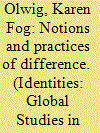

|
|
|
|
|
| Publication |
2013.
|
| Summary/Abstract |
The notion of diversity, which has gained increasing prominence in recent years, promises to rejuvenate migration research in terms of the theoretical and methodological lines of enquiry pursued, the empirical data generated and the interpretations and knowledge produced. By pointing to the existence of many possible forms of differentiation and belonging in social life, it offers a productive alternative to the ethnic framing that has characterised much migration research, whether large-scale quantitative surveys or small-scale ethnographic community studies. It, furthermore, can bring into sharper focus the significance of the temporal and spatial aspects of migration and related processes of inclusion and exclusion. Finally, it can stimulate the development of new, innovative research methods. There is still a need, however, to explore the complex nature of diversity as an empirical phenomenon and analytical concept. This is discussed with particular reference to mobility, contexts of sociality and the politics of academic concepts.
|
|
|
|
|
|
|
|
|
|
|
|
|
|
|
|
| 8 |
ID:
123187
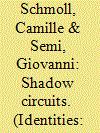

|
|
|
|
|
| Publication |
2013.
|
| Summary/Abstract |
In Italy, as in other southern European countries, both the notions of diversity and multiculturalism have only recently come into use. In this article, we show how over the last 30 years two Italian cities, Turin and Naples have been transformed and reshaped by patterns of mobility and informal commerce that we have referred to as 'shadow circuits'. Shadow circuits work through the connection of distant places in Europe and the Mediterranean and contribute to the understanding of complex, stratified societies, mobile societies in particular. A mobile ethnography perspective has been carried during fieldwork and is discussed in length in this article. The examples of Turin and Naples are particularly useful because, unlike many other Italian cities, both have developed pro-multiculturalism and pro-diversity policies in the last two decades. This makes them particularly interesting case studies for addressing the gap between diversity as a policy and diversity as a social fact.
|
|
|
|
|
|
|
|
|
|
|
|
|
|
|
|
| 9 |
ID:
123191


|
|
|
|
|
| Publication |
2013.
|
| Summary/Abstract |
Based on fieldwork carried out in an urban neighbourhood in south-east England, and using a life-story methodology with a focus on intergenerational change over time, I will analyse the housing outcomes of three ethnic categories - the White British majority population, the British-Italian minority and the British-Pakistani minority. Both minority populations are characterised by early moves into owner-occupancy. But where British-Italians typically have moved 'up and out', there has been a British-Pakistani residential consolidation in a 'comfort zone' where overlaying spheres of community and neighbourhood, underpinned by localised practices of cultural consumption, eventually have come to constitute a spatial and social habitus. Though policy discourse often perceives such practices as indicative of self-segregation, I will here argue that there are similarities between the British-Pakistani comfort zone and the memories of a neighbourhood-based white working-class community, articulated by White British residents.
|
|
|
|
|
|
|
|
|
|
|
|
|
|
|
|
|
|
|
|
|